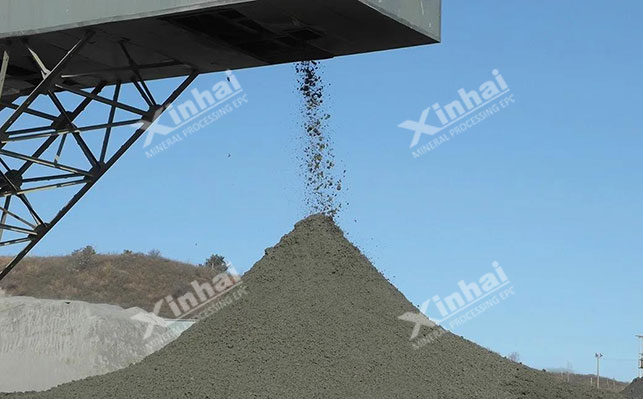Pyrite often occurs as an associated mineral in polymetallic sulfide ores. Due to the relatively low added value of pyrite, it is generally not prioritized during ore dressing, with a focus on recovering major metal minerals. This leads to the loss of pyrite in tailings, resulting in a certain degree of resource wastage.
A certain lead-zinc dressing plant is currently dealing with lead-zinc ore with a high sulfur content, primarily attributed to the presence of pyrite. The plant has a mature process for the recovery of lead, zinc, and sulfur, producing high-quality sulfur concentrate with a grade of 47% and a recovery rate of 90%. However, tests have revealed that there is still some recoverable sulfur in the tailings, with an average sulfur grade of 6% throughout the year, estimating an annual sulfur content of approximately 33,000 tons.

So, how can pyrite in lead-zinc tailings be recovered? In order to better recover this sulfur content, ore dressing experiments were conducted on the lead-zinc tailings, and the research process is outlined below:
A sample of the lead-zinc tailings was analyzed, revealing that the primary metal sulfides in the sample are pyrite, along with trace amounts of magnetic pyrite, arsenopyrite, chalcopyrite, and covellite. Gangue minerals mainly include quartz, calcite, and dolomite, followed by mica, gypsum, and siderite. Other trace minerals include feldspar, garnet, chlorite, kaolin, hematite, ilmenite, amphibole, biotite, apatite, and wollastonite.
Sulfur in the lead-zinc tailings is mainly in the form of pyrite, with a sulfur grade of 9.1%. The dissociation degree of individual pyrite particles is 66.55%, mainly distributed in the particle size range of 20~150 μm, with 38.68% distributed above 74 μm. However, the dissociation degree of pyrite particles larger than 74 μm is only 35.84%, indicating a potential limitation in the dissociation degree.
Preliminary Test Flow
Considering the cost control, the plant utilized four idle flotation machines for the experimental process, with a roughing stage followed by two cleaning stages as the preliminary design. If the dissociation degree of pyrite particles is insufficient, a grinding step will be added. The rougher concentrate will be ground to a certain fineness, and then subjected to two cleaning experiments with an additional acid flotation process.
Flotation Reagent Dosage & Flotation Time Tests
Butyl xanthate: Experimental tests determined a dosage of 250 g/t, achieving a rougher concentrate yield of 23.52%, sulfur recovery rate of 76.12%, and sulfur grade of 25.89%.
Frother (Oil #2): With a dosage of 5 g/t, optimal flotation results were obtained, yielding a rougher concentrate of 24.05%, sulfur recovery rate of 75.84%, and sulfur grade of 25.22%.
Flotation Time: A flotation time of 3 minutes was determined, resulting in a rougher concentrate yield of 23.83%, sulfur recovery rate of 78.95%, and sulfur grade of 26.50%.
Open Circuit Test
After one roughing and two cleaning open circuit experiments, a sulfur concentrate with a grade of 35.5% and a recovery rate of 55.25% was obtained. However, the actual production target requires a sulfur concentrate grade of 46.5% for qualification. Therefore, additional grinding of the rougher concentrate was introduced.
In grinding experiments, the final grinding fineness was set at -40 μm 80%.
After the addition of the grinding step, the open circuit test yielded a sulfur concentrate with a grade of 45.88% and a recovery rate of 53.51%. This significant improvement in sulfur concentrate grade indicates that grinding the rougher concentrate before flotation has a substantial positive effect on the grade.
Closed Circuit Test
Building upon the conditional experiments and open circuit tests, a closed circuit test was conducted. The process is illustrated in the diagram, and the results are summarized in the table below:
Despite achieving a sulfur concentrate grade of 42.58% and a recovery rate of 60.14% in the closed circuit test, it did not meet the production standards as a standalone high-grade sulfur concentrate product. However, it can be blended with high-grade sulfur concentrate produced in the plant for sale as a standard sulfur concentrate, potentially increasing annual revenue by 15.4 million RMB.
After comprehensive and scientific ore dressing experiments, the final process for recovering pyrite in lead-zinc tailings is determined as follows:
After one roughing, grinding the rougher concentrate to a fineness of -40 μm 80%, followed by two cleaning and one scavenging in a closed circuit flotation process, a sulfur concentrate with a grade of 42.58% and a recovery rate of 60.14% is obtained. The tailings grade is reduced from 8% to 3.59%.
Combining the sulfur concentrate obtained from the experiment with the high-quality sulfur concentrate produced in industrial production. Theoretically, under the condition of not compromising the sulfur concentrate sales requirements, an additional 77,000 tons of standard sulfur (with a sulfur grade of 35%) can be recovered annually.
This case illustrates that although the added value of pyrite is low, its value is still significant if the tailings contain a high content of pyrite, and when the tailings discharge volume is considerable. Tailings are not necessarily waste; they can also be a treasure, depending on how they are utilized!